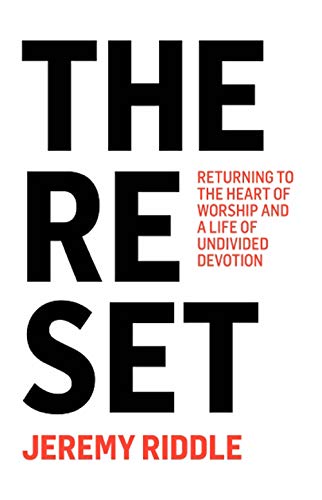Review: The Reset – Returning to the Heart of Worship and a Life of Undivided Devotion
 The deconstruction is real. The pandemic season is lingering and the waves of its wake are more disruptive, more disturbing, more confusing than the sudden crisis with which it struck.
The deconstruction is real. The pandemic season is lingering and the waves of its wake are more disruptive, more disturbing, more confusing than the sudden crisis with which it struck.
It’s real everywhere. It is, certainly, in the church. Now is the time when things are being questioned. Now is the time of being undone.
We used to have forms and structures and predictable routines; we could hide in them and deflect away those deeper things we feared to face. Perhaps we imagined easing back into comfortable unchallenging modes of common life. But covid has ripped the covers off of us, and the substance, or otherwise, of our exposed core cannot be unseen. It moves us, it frightens us, it shakes us. Is it any surprise that even the biggest American denominations are being rocked and refined by scandal after scandal. It’s in the UK too. Covid was not a crisis for the church, it has been a catalyst; the crisis is coming. Are we ready?
Jeremy Riddle is a world famous worship leader, currently on the team at Vineyard Anaheim in California, and formerly of Bethel. You will have heard his music. There might perhaps be one higher level in the pantheon of professional praisers (the Order of St. Tomlin perhaps?) but he’s up there at the pinnacle of the religio-industrial complex. Wonderfully, beautifully, and above all Christianly, he’s questioning it all.
I’m writing this book in the midst of a global pandemic that has shut down church services, programs, conferences, and Christian events of almost every kind. This is a moment of reset (Page 119)
The book isn’t long. It isn’t actually all that insightful, in the sense of saying something new. For instance, we’ve all known for some time that there is something “off” in the industry of Christian worship. It’s refreshing to have it explicated from someone in the know. “The model [of the “Christian” music industry”] may still be useful to Christian music artists and bands,” he says (page 88), “but apart from a deep work of repentance and reformation, I don’t believe this industry is fit to carry and release the new sound of worship God is about to pour out.” Later, he writes about the “lack of kingdom ethics and practice”, “secular leadership”, and the lack of witness and accountability within the supplier space of the Christian market. He looks for reformation with regard to event management, stage production, performance drive, social media, and influence. They are important critiques, and this isn’t merely a tearing-down whinge; it’s the launching place for a positive vision (more on that in a minute). And he shows his working.
Chapter by chapter he reveals his heart that we might “cease playing Christian music games” (Introduction). He reveals (Chapter 1) his perspective on the recent history of Christian music, and the “worship movements” which have dominated the charismatic world; he wants to reclaim something of the purer creativity that was there at the beginning of the charismatic renewal. I know what he means; I still separate the charismatic world into “old-school” Spirit-driven wing-and-a-prayer crazy-but-faithful, and the stage-managed program-driven risk-averse-consumerism dominant variant. He lays the foundation:
Worship is the sound of a covenantal people; a people betrothed to Jesus. It is the sound of their love, adoration, and zealous devotion to the only One found worthy! (Page 8)
He appeals for a greater purity (Chapter 2) that opposes idolatry, particularly that of popularity. He imagines worship that sounds a lot like discipleship – costly, eternally-minded, driven by love, and built on our weakness and the gift of life’s pains in which we have nothing left but a life of faith. He wants to get our eyes off of our ourselves and onto Jesus (Chapter 3) and so be marked for a zeal for reform, beginning in the “internal temple” of our own hearts (page 37). Indeed, the shape of what it takes to become “wholehearted” (Chapter 4), is to embrace “our death” (page 41), the cruciform road of a life surrendered to God. This is the heart of worship, informed by the “joy set before” us (page 50).
If the call doesn’t require you to lay your life down, it’s less than the call of Jesus. If the call doesn’t cost you everything you have to obtain it, it’s less than the call of the gospel. (Page 47)
It was at this point, that my reading become less academic and more soul-searching. His deconstruction resonates with my own. In his chapter on “dreams” (Chapter 5), my own heart ached. I know what it’s like to dream youthful dreams, and launch forward with missional zeal. I also know what it’s like for my dreams to be my idols that were “keeping me from surrender” (page 53). But without dreams, the joy of the Lord is elusive. The chapter explicates the problem, and it took the rest of the book for that tension to resolve. Chapter 6 (“Born of the Spirit”) begins to prod at that path. “The presence is a person”, he says (page 64), and this is the beginning of the touchpoint for me. Here’s something I’ve learned from my own deconstruction: I miss Jesus.
I’ve got a pretty good handle of the doctrine of Jesus. That is necessary and good, and I appreciated how Riddle asserts the place of Biblical truth (Chapter 7). But, (to quote him quoting J I Packer), the goal of theology is doxology (page 77), and that’s what I miss. In my youthful zeal, I was David dancing before the ark. In the desert of my undoing, I am Elijah in a cave of depression, missing the still small voice. I have struggled to yield to the Word of God, not because I despise it, but because, like Jeremiah, I don’t want it to burn in my bones with nowhere to go. We often sit in silence, my Lord and I, and he is more patient than me.
I think, this is where I’m at in my deconstruction: I am learning to speak. Not the preaching, praying, performing type of talk, rather I am learning to talk to Jesus again. He is present as a person, you see. I am learning to trust. I am no passivist, but I cannot generate the Kingdom of God. I cannot even build it. My agency is not my own, it is his, and all I can do is be used each day. I’ve spent too many years hiding in the striving, or curled up in a wearied whirl. Now it is time to simply be, with him, content to know and be known by him. I miss it, because I know it from my childlike youth. I want to discover it, because I’ve never been here before.
So come on, Jeremy Riddle! Tell me about “mothers and fathers of worship who have allowed their voices to be silenced, quieted and tamed” for whom “the pain of life, disappointment, personal failure and misunderstanding have taken the wind out of your sails” (page 119). There is prophetic truth in your words about old flames burning in our latter years, hungry for true, deep, yielding, cruciform, intimate, worship. This shakes and wakes my heart.
Here is a picture of “the future” (Chapter 10). We have encountered a similar vision in a number of places; it’s not about a particular plan or movement, but a bringing together:
Here is what I desire to see: I desire to see the worship movement marry the prayer movement and the missions movement. I firmly believe that if worship is re-anchored in ministry to the Lord and ministry to the world, it will explode with fresh life, creativity and power. (Page 111)
Time and time again, at the moment, we find a visceral reaction against “going back to the ways things were.” No one has the passion to merely put back the forms of church. Rather, we are hearing language of integration at every level. At the structural level it’s there – a push back at specialisations and homogenous units (imagine worshippers and evangelists and prophets and pastors together in community!). And it’s there in a desire to integrate worship life and work life and home life and inner life. There’s a yearning to live out of rhythms of grace in a Kingdom that is not just for Sunday mornings, but breakfast tables, and conversations in the park, and for when life sucks. At the same time as churches are starting to count how many are “coming back”, dispersed monastic communities like the Order of the Mustard Seed are facing surges of interest. In fact, they put out a podcast this year on “apostomonasticism.” It captures a similar vision to Riddle’s.
In the end, though, it’s a challenge. It challenges me personally. This books imagines “a new expression of an ancient kind of worship leader… leaders whose lives of devotion are once again rooted in the rhythms of prayer and the mission of Jesus” (page 112). I yearn for this, I aspire to it. And here’s the rub: It can’t be striven for, not by myself. It challenges us leaders because it gets to the heart of it all, the necessary “mark of intimacy” (page 114). I miss Jesus. I need to talk to him again.
As covid begins to wane, the real crisis is appearing. For us leaders it will be a new set of expectations, perhaps some pressure to perform in some wonderfully Christian, churchy way. It’s easy to cry “let’s get back into it.” My self-exhortation is to only have one primary pursuit: prayer first, intimacy with Jesus first, to be the sheep that knows the shepherd’s voice. It feels like we’re starting from scratch, but that’s ok. This is a waking-up season, an open-the-door-after-the-storm season, a sort-through-the-rubble season. It’s a stripped-back-to-the-only-one-who-is-truly-real season. It’s the season to sit at his feet. We are in a grace-filled reset.




